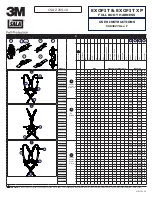
A-25
A2
A2.4
RS-530 PINOUTS
In 1987, the EIA released a new standard, EIA-530, for high speed
signals on a 25 pin connector. This new standard combined the older
RS-232 single-ended signals and the newer RS-422/RS-485
differential signals on one connector. The advantage of the RS-530
specification is that it established a pin out standard for RS-422/RS-
485 signals on a 25 pin connector and at the same time provided for
the presence of both signals on the same connector.
The 2303 serial interface conforms to the EIA-530 Standard and uses
internal jumpers to select the active signal levels on its serial interface.
The 2303 is designed so that it may receive either single ended RS-232
or differential RS-422/RS-485 signals.
A2.5
SERIAL INTERFACE PROBLEMS
Most of the problems that arise when connecting serial devices can be
avoided if the user will compare the signals on both devices' interfaces
before plugging them together. The obvious things to look for are:
1. Verify transmit and receive data direction and pin numbers.
DTE devices mate directly with DCE devices while DTE
and DTE connections need to be crossed.
2. Check needed control lines. Some devices need signal
inputs, others can function with open inputs. All inputs
need a valid signal level. If in doubt add jumpers to a
known 'on' signal such as the devices's DTR or DSR
output signal.
3. Same baud rates. Different baud rates result in garbled
data.
i.e.,*!1-












































